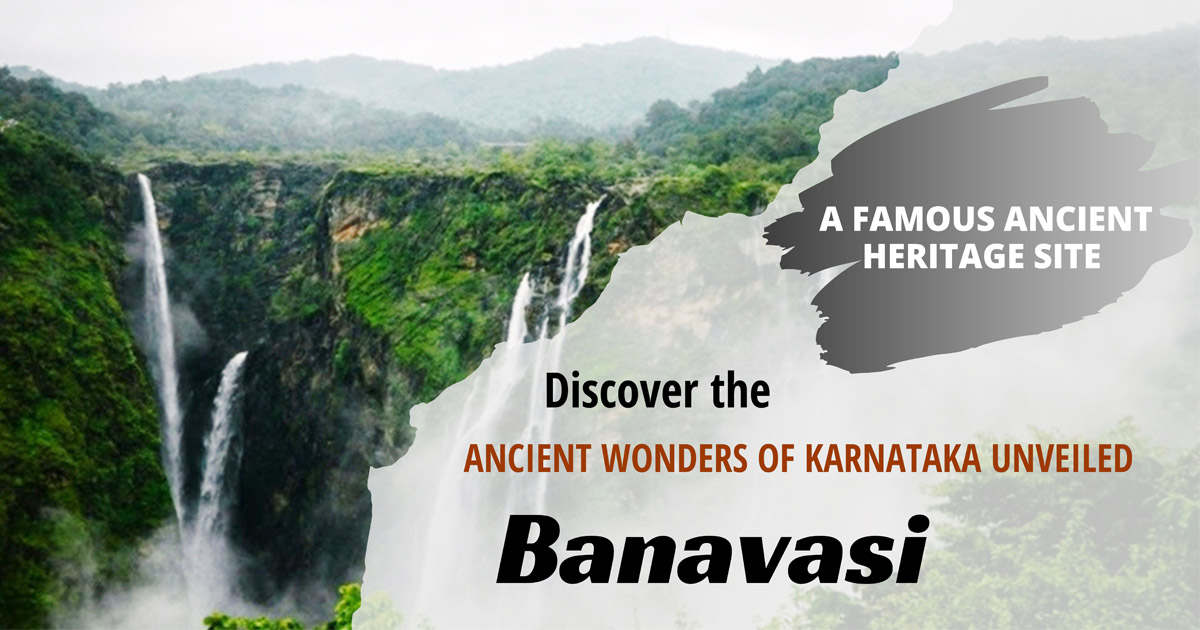
Introduction
Banavasi, a small town located in the Indian state of Karnataka, is a place of immense historical and cultural significance. With a rich heritage dating back thousands of years, Banwasi offers a glimpse of the region’s glorious past. In this article we will give you information about Banwasi historical landmarks, cultural treasures and interesting stories related to Banwasi.
Table of Contents
A Brief History of Banavasi
A brief history of Banavasi takes us back in time to trace the origins and historical significance of this ancient city in Karnataka. Nestled amidst the lush greenery of the Western Ghats, Banwasi has a rich past dating back two millennia. The history of Banavasi begins with the rise of the Kadamba dynasty, which established its capital in the city around the 4th century. The Kadambas were an influential dynasty that played a significant role in shaping the political and cultural landscape of the region. During his rule, Banavasi developed as a major center of art, culture and trade.
During the Kadamba period the Banavas experienced a golden age of artistic and architectural development. The dynasty’s patronage of art led to the construction of numerous temples and architectural marvels, many of which still stand as testaments to their magnificence. These structures exhibit exquisite craftsmanship and reflect a blend of various architectural styles, including Dravidian and Nagara.
Banwasi’s strategic location near the Ararik B Sea and the Western Ghats made it an important trading centre. Traders from different parts of the world visited the city, established trade networks and contributed to its prosperity. The city’s thriving economy and cultural vibrancy attracted scholars, artists and intellectuals, making it a center of learning and creativity.
Over the centuries, Banavasi has seen the rise and fall of various dynasties, including the Chalukya, Rashtrakuta, Hoysala and Vijayanagara empires. Each dynasty left its mark on the city, influencing its architecture, traditions and cultural practices. Banavasi’s decline as a major political and cultural center began with the decline of the Kadamba dynasty in the 6th century. However, the city retained its historical and cultural significance. The temples, sculptures and inscriptions that dot Banwasi’s landscape are a lasting reminder of its glorious past.
Today, Banwasi attracts history buffs, art lovers and spiritual seekers who are drawn to its historical landmarks and cultural heritage. The Archaeological Survey of India (ASI) has taken initiatives to preserve and restore ancient temples and structures, so that future generations can learn about the city’s rich history. The history of Banavasi traces its journey from being the capital of the Kadamba dynasty to becoming a cherished place that gives a glimpse of Karnataka’s ancient past. The city’s historical significance, architectural marvels and cultural heritage make it a fascinating place to explore and understand the origins of Indian civilization.
Also Read: Bandaje Falls: Experience the mesmerizing beauty of Karnataka tourism.
Legacy of the Kadambas
The legacy of the Kadambas refers to the lasting influence and contribution of the Kadamba dynasty, a powerful ruling dynasty that played an important role in the history of Banavasi and the surrounding regions of Karnataka, India. The Kadambas left a rich cultural, artistic and architectural legacy that is celebrated and admired even today.
The Kadambas rose to prominence in the 4th century AD and established their capital at Banvasi, making it a center of political and cultural power. He ruled over a vast territory covering present day Karnataka and Goa and parts of Maharashtra. During their reign, the Kadambas created a flourishing and prosperous kingdom and left a lasting impression on the region. One of the most remarkable aspects of the Kadamba legacy is their patronage of art. He was a great supporter of literature, poetry and performing arts, nurturing a rich cultural environment in his kingdom. Scholars and artists came to Banavasi and contributed to the growth of the literary and artistic scene. The Kadamba rulers themselves were known for their literary works and their courts became centers of intellectual exchange.
The architecture of the Kadambas is also a testament to their legacy. He built numerous temples and architectural marvels, demonstrating his keen aesthetic sensibility and architectural prowess. The Kadamba temples display a unique blend of architectural styles, including elements of Dravidian and Nagra architecture. Intricate carvings, elaborate sculptures and exquisite craftsmanship are the hallmarks of their architectural creations.
One of the most famous temples associated with the Kadambas is the Madhukeshwar temple at Banavasi. Dedicated to Lord Shiva, this temple is a masterpiece of his architecture. The temple’s intricate carvings, tall gopuram (gateway tower), and beautifully decorated sanctum sanctorum reflect both the religious and artistic devotion of the Kadambas.
The legacy of the Kadambas extends beyond art and architecture. He was known for his administrative acumen and governance, implementing an effective system of governance and promoting social welfare. The dynasty fostered a sense of unity among the various communities and worked for the welfare of their subjects. Although the power of the Kadambas declined by the sixth century AD, their legacy continued. Their contributions to literature, art, architecture and governance laid the foundation for subsequent dynasties that ruled the region. Karnataka owes its cultural heritage to the Kadambas, as their reign marked a golden age of artistic and intellectual achievement.
The temples and structures built by the Kadambas continue to attract tourists and serve as a testament to their grandeur and cultural influence. The legacy of the Kadambas is a testament to their significant contribution to the cultural, artistic and architectural heritage of Banavasi and Karnataka. Their patronage of art, architectural marvels and administrative achievements have left an indelible mark on the region’s history and continue to inspire awe and admiration.
Temples and architectural marvels of Banavasi
The temples and architectural marvels in Banwasi testify to the region’s rich artistic and architectural heritage. The city is famous for its ancient temples that display a unique blend of exquisite craftsmanship, intricate carvings and architectural styles. These architectural marvels are not only places of worship but are also famous as cultural and historical landmarks, attracting tourists from far and wide.
One of the major temples in Banavasi is the Madhukeshwar temple, dedicated to Lord Shiva. This temple is a masterpiece of architecture. Its walls, pillars and ceiling are intricately carved, depicting various mythological scenes and deities. The gopuram (gateway tower) of the temple stands tall, attracting attention and adding to the grandeur of the structure. The sanctum sanctorum of Madhukeshwar Temple creates a spiritual atmosphere, inviting devotees to seek solace and divine blessings.
The architectural style of Madhukeshwar Temple reflects a harmonious blend of Dravidian and Nagra styles. The pyramid-shaped plane (buruj) rising above the sanctum sanctorum shows Dravidian influence, while the Nagara style is evident in the intricate carvings and decorative elements. This fusion of architectural styles creates a unique and fascinating visual experience for visitors.
Another notable temple in Banavasi is the Chandika Temple, a temple dedicated to Goddess Chandika. The temple shows a similar blend of architectural styles with intricately carved pillars and walls. The sculptures adorning the temple depict various mythological stories and deities, while also depicting stories from ancient Hindu scriptures.
Banavasi architecture extends beyond these two temples. There are many smaller temples and structures exhibiting remarkable craftsmanship and architectural intricacy. These temples, though small in size, contribute to the overall architectural landscape of Banvasi and show an insight into the artistic brilliance of the earlier era.
A visit to these temples and architectural marvels in Banwasi gives a glimpse of the region’s rich heritage and artistic traditions. The intricate carvings, grandeur of the architecture and the spiritual atmosphere create a captivating experience for the visitors. Exploring these temples allows one to appreciate the skillful craftsmanship of the ancient artisans and the devotional and cultural heritage that continues to flourish in Banvasi.
Folktales and legends in Banavasi
Folklore and legends among the Banwasi weave a tapestry of captivating stories and legends passed down from generation to generation. These tales form an integral part of the city’s cultural heritage and add to its mystery and enchantment. Banwasi is home to a rich collection of folklore and legends that reflect the beliefs, values and traditions of the local community.
A popular legend associated with Banavasi revolves around the Madhukeshwar temple dedicated to Lord Shiva. According to legend, this temple was built around a natural cave where Lord Shiva resided. It is believed that there is a secret passage in the cave that leads to a hidden treasure. The legend has fueled the imaginations of treasure hunters and adventurers for centuries, and the temple has added an air of mystery and intrigue to its surroundings.
Another fascinating folk tale is the story of the origin of Banavasi. According to folklore, Banavasi was founded by King Vallabh, who was famous for his piety and devotion to Lord Shiva. The king sought the blessings of Lord Shiva and guided him to a beautiful land surrounded by lush green forests, where he founded the city of Banavasi. The story symbolizes the city’s divine origin and connection with spiritual forces.
Legends also surround some natural landmarks in Banwasi. Vibhuti Falls, a picturesque waterfall located near Banavasi, has its own mystical story. It is believed that the water of the falls has healing properties. Visitors often visit Vibhuti Falls hoping to experience its purported curative effects. These folktales and legends from Banavasi not only entertain but also impart deep meaning and lessons. They often express moral values, teachings and cultural norms. Stories serve as a medium for passing on traditions, instilling virtue and strengthening the cultural identity of a community.
Oral tradition has played an important role in preserving and transmitting these folklores and legends among the Banwasi. Storytellers, often elders or local artists, share these stories during festivals, gatherings and cultural events. Narratives are rich with vivid descriptions, dramatic elements and local dialects, captivating the audience and engaging their imagination.
In recent times, efforts have been made to document and preserve these folklores and legends. Scholars and researchers have collected and recorded these stories for their longevity and to enhance the rich folklore heritage of the Banvas. Cultural festivals and events in Banwasi often feature performances that bring these stories to life through music, dance and theatre, providing a platform to celebrate and preserve the town’s folk traditions.
Visitors to Banavasi should not miss the opportunity to immerse themselves in this fascinating world of folklore and legends. These stories add depth and meaning to the city’s historical and cultural landscape, offering a unique glimpse into the beliefs, customs and imagination of the Banwasi people. Banavasi folklore and legends are a treasure trove of stories handed down from generation to generation. They contribute to the cultural heritage of the city, enthralling visitors with their legends, moral lessons and cultural significance. Exploring these stories provides a deeper understanding of the traditions and beliefs that have shaped the Banwasi identity over time.
Also Read : Maravanthe Beach: Discover the Breathtaking Beauty of Nature in Udupi District!
Natural beauty and tourist attractions in Banwasi
The natural beauty and tourist spots in Banwasi create an attractive and peaceful environment for tourists. Nestled in the lush greenery of the Western Ghats and surrounded by rivers and rolling hills, Banwasi enjoys a picturesque landscape that enthralls nature lovers and adventure seekers. One of the major natural attractions in Banavasi is the Vibhuti Falls. Located on the outskirts of the city, Vibhuti Falls is a mesmerizing waterfall that mesmerizes tourists with its raw beauty. The cascading water and lush green surroundings create a picturesque setting, making it a popular destination for photography enthusiasts and nature lovers. The waterfall provides a refreshing and rejuvenating experience and many tourists enjoy taking a dip in the cool water.
Banwasi is home to numerous forests and wildlife, making it an ideal destination for nature lovers and wildlife lovers. The forests surrounding the city are full of diverse flora and fauna, offering opportunities for bird watching, nature walks and wildlife viewing. Tranquil atmosphere, chance to meet rare and exotic species make these natural habitats a must visit for nature lovers.
For adventure seekers, Banwasi offers plenty of opportunities for trekking and hiking. High hills and scenic trails provide the perfect backdrop for outdoor activities. Treks to nearby peaks and hills offer breathtaking panoramic views of the surrounding landscape, giving trekkers a sense of accomplishment and an opportunity to connect with nature on a deeper level.
Banavasi is not only a haven for nature lovers; It also has a rich cultural heritage that attracts history buffs and art lovers. The city is home to ancient temples that are architectural marvels in their own right. The Madhukeshwar temple, with its intricate carvings and spiritual atmosphere, attracts devotees and art lovers from far and wide. The Chandika Temple, displaying a blend of architectural styles, is another highlight of the region’s cultural and artistic prowess.
Exploring the city is a joy, as the streets are lined with charming old houses and traditional structures that reflect the cultural heritage of Banwasi. Local markets offer a glimpse into the region’s vibrant and colorful traditions, where visitors can shop for traditional handicrafts, handloom textiles and other local products.
To enhance the experience of natural beauty and tourist attractions in Banwasi, various eco-tourism activities have been initiated. These initiatives focus on sustainable tourism practices, promote the conservation of the natural environment and create awareness about the importance of preserving the region’s biodiversity.
Banwasi’s natural beauty and tourist attractions offer a fascinating and enriching experience to tourists. Waterfalls, forests, hills and historical landmarks create a harmonious blend of nature, culture and heritage. Whether seeking adventure, tranquility or a deeper connection with nature, Banwasi offers an exhilarating journey through its natural wonders and cultural treasures.
Preserving the cultural heritage of Banavasi
Preserving the cultural heritage of Banwasi is of utmost importance to ensure that the city’s rich traditions, historical significance and artistic heritage are passed on to future generations. Efforts are being made by various organizations and stakeholders to protect and promote the cultural heritage of Banvasi. Archaeological Survey of India (ASI) plays an important role in the preservation and maintenance of historical sites and structures in Banwasi. ASI conducts research, conservation and restoration activities to protect architectural marvels and ensure their longevity. Through careful documentation, scientific analysis and structural repairs, ASI strives to preserve the authenticity and integrity of these cultural treasures.
Education and awareness programs play an important role in preserving cultural heritage. Schools, colleges and local organizations in Banwasi are actively involved in promoting the city’s history, arts and traditions. Cultural festivals, exhibitions and workshops are organized to showcase heritage and provide a platform for artists and artisans to display their skills and crafts. Such activities help create awareness among local communities and visitors about the importance of preserving cultural heritage. Community participation is important for the sustainable preservation of cultural heritage. Local communities in Banwasi are encouraged to actively participate in heritage conservation activities. This includes raising awareness, volunteering for conservation initiatives and participating in cultural programs and events. By involving the community, creating a sense of ownership and responsibility, preservation of cultural heritage becomes a collective effort.
Documentation and archiving play an important role in preserving cultural heritage. Oral history, folklore, traditional practices and artistic techniques are recorded and documented, ensuring that they are not lost over time. Museums and cultural centers in Banwasi serve as repositories of artefacts and historical objects, providing space for research, exhibition and education.
Collaboration between experts, practitioners and researchers is important for preserving cultural heritage. By developing partnerships with educational institutions, museums and other heritage institutions, Banavasi can benefit from expertise in research, conservation techniques and heritage management. These collaborations ensure that best practices are implemented to preserve and enhance the city’s cultural heritage.
Preserving the cultural heritage of Banwasi requires a multi-pronged approach involving government agencies, local communities, educational institutions and tourists. Through efforts in conservation, education, community engagement, documentation, sustainable tourism and collaboration, the rich cultural heritage of Banwasi can be preserved, celebrated and passed on to future generations, ensuring a legacy that will last for years to come.
Conclusion
Banavasi is a living proof of India’s ancient heritage. Its historical landmarks, architectural marvels, intriguing legends and natural beauty create an enchanting experience that takes visitors on a fascinating journey through time. As Banwasi preserves and promotes its cultural heritage, it invites travelers to explore its rich history and learn its many secrets. Visit this historic place.
Frequently Asked Questions (FAQs)
How can I reach Banvasi ?
To reach Banwasi, you can take a flight to Hubli Airport, which is the nearest airport. Or you can reach Hubli by bus of Karnataka State Transport and from there, you can take taxi or bus to Banvasi.
Are there accommodation options available in Banwasi?
Yes, Banwasi offers several accommodation options like hotels and guesthouses to suit different budgets and preferences.
Can I visit Banwasi throughout the year?
Yes, Banavasi can be visited throughout the year. However, the cool months of October to February are considered the best time to visit due to the pleasant weather.
Are there any other attractions near Banwasi ?
Yes, there are many other attractions near Banwasi, including Jog Falls, one of the tallest waterfalls in India, and the historic city of Hampi, a UNESCO World Heritage Site.
What should I try in the local cuisine of Banavasi ?
While in Banwasi, don’t miss the opportunity to taste local delicacies like Kundapura Chicken, Neer Dosa and Mangalore Buns.
Which temples in Banvasi are must see ?
Madhukeshwar Temple and Chandika Temple are the famous temples in Banavasi that you should not miss.
Is Banwasi a popular tourist destination ?
Yes, Banavasi is gradually gaining popularity among history buffs, art lovers and nature seekers who appreciate its historical and cultural significance.
What is the best time to visit Banwasi ?
The best time to visit Banwasi is during the winter months of October to February when the weather is pleasant to explore the city and its surroundings.







